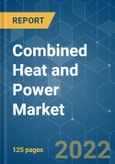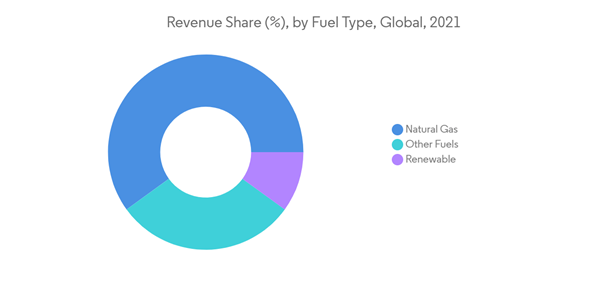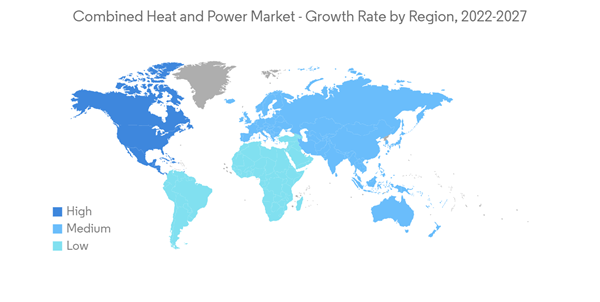Key Highlights
- Natural gas-based fuel type is expected to grow significantly in the global combined heat and power market during the forecast period.
- Small-to-medium size industrial facilities could benefit from flexible and cost-effective combined heat and power systems. Such systems have the benefit of conventional combined heat and power but could also provide support to the electricity grid in the form of electricity supply, frequency regulation, and reserve capacity. This, in turn, is expected to create significant opportunities for the combined heat and power system providers and plant developers in the near future.
- North America has dominated the combined heat and power market, with the majority of the demand coming from the United States and Canada.
Key Market Trends
Natural Gas-based Fuel Type to Witness a Significant Growth
- Over the past few years, the natural gas industry has grown significantly. Natural gas combustion is a relatively clean process when compared with other fossil fuels. Combined heat and power can be a very useful technology for sites that have a constant demand for both heat and electricity, particularly when the site is off the main grid and where natural gas fuel is readily available.
- Factors such as increasing support for natural gas production and associated infrastructure and decreasing natural gas production prices are expected to drive the natural gas fuel in the CHP market in the forecast period.
- In November 2021, the University of Montana broke ground on a new combined heat and power facility that is expected to reduce its greenhouse gas emissions by more than 20%. The new CHP plant uses natural gas to create electricity through two turbines, and the waste heat from that process will be used to boil water to create steam to heat the campus.
- In October 2021, the Chia Hut Combined Heat and Power plant project in Taiwan started its commercial operations. The plant runs on natural gas and has 7HA.02 gas turbines supplied by General Electric.
- In September 2021, a USD 30.1 million combined heat and power project was approved to be set up at the Jackson Pike plant in Columbus City, United States. The CHP plant is likely to use methane produced through treating wastewater which is currently flared off to fuel two steam generators to produce electricity to run and heat the plant.
- Thus, taking account of the above-mentioned points, the natural gas-based fuel type segment is likely to experience significant growth during the forecast period.
North America to Dominate the Market
- North America has dominated the combined heat and power market and is expected to continue its dominance in the coming years as well.
- A reliable and resilient grid is critical to the economic growth and energy security of countries like the United States. As the country's grid interconnects a growing number of renewable energy sources, such as wind and solar, the intermittent nature of power generation from these sources is creating challenges for power system operations. Electric utilities and other system operators are facing an increasing and immediate need for additional power to keep the electric grid stable and secure.
- Combined heat and power technologies can help manufacturing facilities, federal and other government facilities, commercial buildings, institutional facilities, and communities reduce energy costs and emissions, and provide more resilient and reliable electric power and thermal energy.
- In November 2021, the University of Montana broke ground on a new combined heat and power facility that is expected to reduce its greenhouse gas emissions by more than 20%. Once the plant is up and running, it is expected to save the university up to USD 2 million per year.
- Also, in October 2021, the Department of Energy (DoE), United States, selected Ohio State as one of 10 connected community sites to receive a USD 4.2 million DOE grant to be used over the next five years. The energy assets include a 105 MW combined heat and power plant, multiple central chiller plants; a steam plant; 65,000 square feet of solar power photovoltaics; 29 electric vehicle charging stations; and 50 megawatts of wind energy through a power purchase agreement.
- In April 2021, the Canadian government announced a CAD 8.4 million investment in nine community-led indigenous clean energy projects across British Columbia. Three projects out of the nine incorporate setting up of a new combined heat and power plant.
- In 2020, the California government amended the feed-in tariff to stimulate the deployment of CHP units with less than 20 MW capacity. The FIT price is coupled with natural gas prices adjusted by day and season (Market Price Referent (MPR). The nation's FIT is not preempted by Federal Energy Regulatory Commission (FERC) as long as the CHP generators are qualified facilities and the rate does not exceed the avoided cost. FERC approved California's FIT design that included multi-tiered rates and adders for transmission constraints and environmental externalities. The country has also targeted to achieve 6.5 GW of new CHP installation by 2030.
- Thus, owing to the above-mentioned factors, the North American region is likely to dominate the global CHP market during the forecast period.
Competitive Landscape
The combined heat and power market is moderately fragmented. Some key players in this market include General Electric Company, Kawasaki Heavy Industries Ltd, Bosch Thermotechnology GmbH, Viessmann Werke Group GmbH & Co. KG, and Siemens Energy AG.
Additional Benefits:
- The market estimate (ME) sheet in Excel format
- 3 months of analyst support
This product will be delivered within 2 business days.
Table of Contents
Companies Mentioned (Partial List)
A selection of companies mentioned in this report includes, but is not limited to:
- MAN Diesel & Turbo SE
- Centrica PLC
- Caterpillar Inc.
- Mitsubishi Electric Corporation
- General Electric Company
- Kawasaki Heavy Industries Ltd
- Bosch Thermotechnology GmbH
- Viessmann Werke Group GmbH & Co. KG
- FuelCell Energy Inc.
- Seimens Energy AG
- Wartsila Oyj Abp
- ABB Ltd
- Aegis Energy Services LLC










